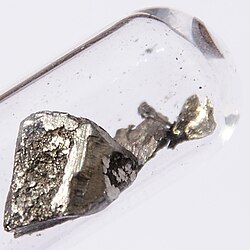Lanthanum
Lanthanum is a chemical element with the symbol La and atomic number 57. Lanthanum is a silvery white metallic element that belongs to group 3 of the periodic table and is the first element of the lanthanide series. It is found in some rare-earth minerals, usually in combination with cerium and other rare earth elements. Lanthanum is a malleable, ductile, and soft metal that oxidizes rapidly when exposed to air. It is produced from the minerals monazite and bastnäsite using a complex multistage extraction process. Lanthanum compounds have numerous applications as catalysts, additives in glass, carbon lighting for studio lighting and projection, ignition elements in lighters and torches, electron cathodes, scintillators, and others. Lanthanum carbonate (La2(CO3)3) was approved as a medication against renal failure.
Occurrence
Monazite (Ce, La, Th, Nd, Y)PO4, and bastnäsite (Ce, La, Y)CO3F, are the principal ores in which lanthanum occurs, in percentages of up to 25 to 38 percent of the total lanthanide content. In general, there is more lanthanum in bastnäsite than in monazite. Until 1949, bastnäsite was a rare and obscure mineral, not even remotely contemplated as a potential commercial source for lanthanides. In that year, the large deposit at the Mountain Pass rare earth mine in California was discovered. This discovery alerted geologists to the existence of a new class of rare earth deposit, the rare-earth bearing carbonatite, other examples of which soon surfaced, particularly in Africa and China.
| Symbol | La | |
| Atomic Number | 57 | |
| Atomic Weight | 138.9055 | |
| Oxidation States | ||
| Electronegativity, Pauling | 1.1 | |
| State at RT | Solid, Metal | |
| Melting Point, K | 1194 | |
| Boiling Point, K | 3730 |
Appearance and Characteristics
Harmful effects:
Lanthanum and its compounds are considered to be moderately toxic.
Characteristics:
- Lanthanum is a silvery-white soft metal, which can be cut with a knife.
- It is ductile, malleable and exposed surfaces tarnish rapidly in air forming the oxide.
- Lanthanum reacts with water to form lanthanum hydroxide plus hydrogen gas.
- Lanthanum is chemically reactive and forms compounds with carbon, nitrogen, boron, selenium, silicon, phosphorus, sulfur, and with the halogens.
- Lanthanum usually exists as a trivalent ion, La3+, in its compounds.
Uses of Lanthanum
- Lanthanum is used in large quantities in nickel metal hydride (NiMH) rechargeable batteries for hybrid automobiles. The negative electrode (cathode) in NiMH batteries is a mixture of metal hydrides – one of which is typically lanthanum hydride. The active material at the cathode is hydrogen, which is stored in the metal hydride structure. The metal hydride can, depending on its composition, hold between 1% and 7% hydrogen by weight. A Toyota Prius battery requires about 10 kg of lanthanum.
- Lanthanum is used as a petroleum cracking catalyst, catalyzing the splitting of long chain hydrocarbons into shorter chained species.
- Lanthanum is used as an additive to make nodular cast iron and as an additive in steel.
- Flame lighter flints use misch metal (a rare earth alloy) containing lanthanum to produce sparks by friction.
- Lanthanum is used in hydrogen sponge alloys, which take up to 400 times their own volume of hydrogen gas.
- Lanthanum is also used to make night vision goggles (infrared-absorbing glass).
- High quality camera and telescope lenses contain lanthanum oxide (La2O3) making use of its high refractive index and low dispersion.
- Lanthanum carbonate is used to reduce blood levels of phosphate in patients with kidney disease.
- Lanthanum compounds are also used in some pool products to reduce the level of phosphate nutrients that algae feed on.
A brief introduction to the lanthanides.
Lanthanum decanting at Ames Laboratory produces some of the purest lanthanum in the world.
